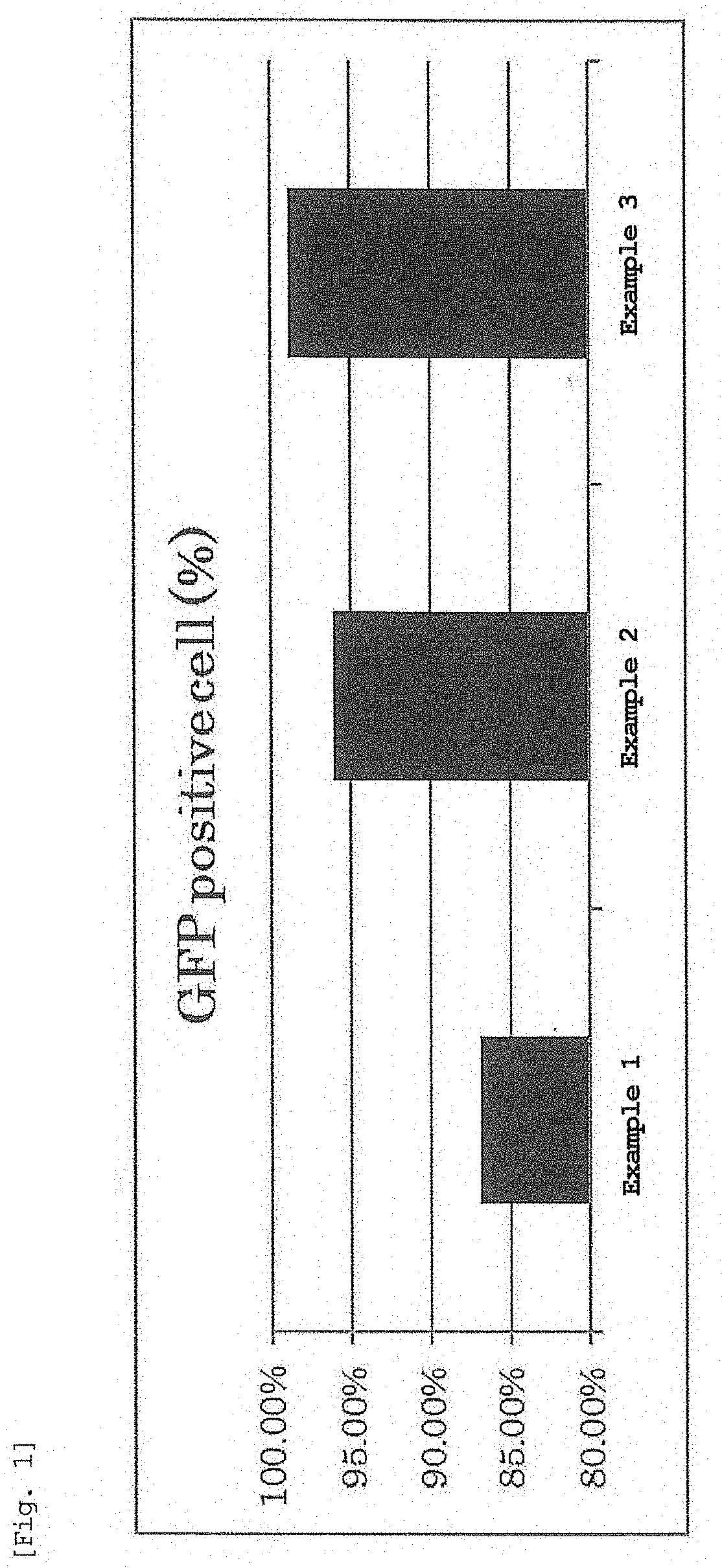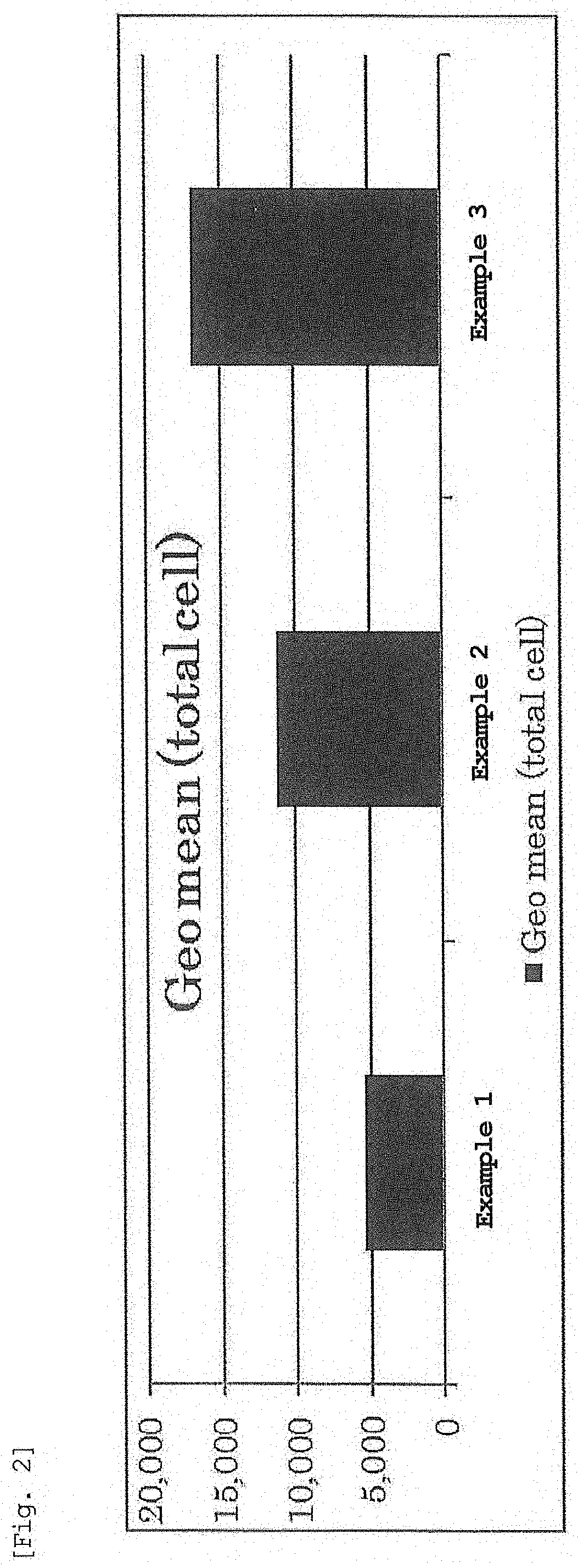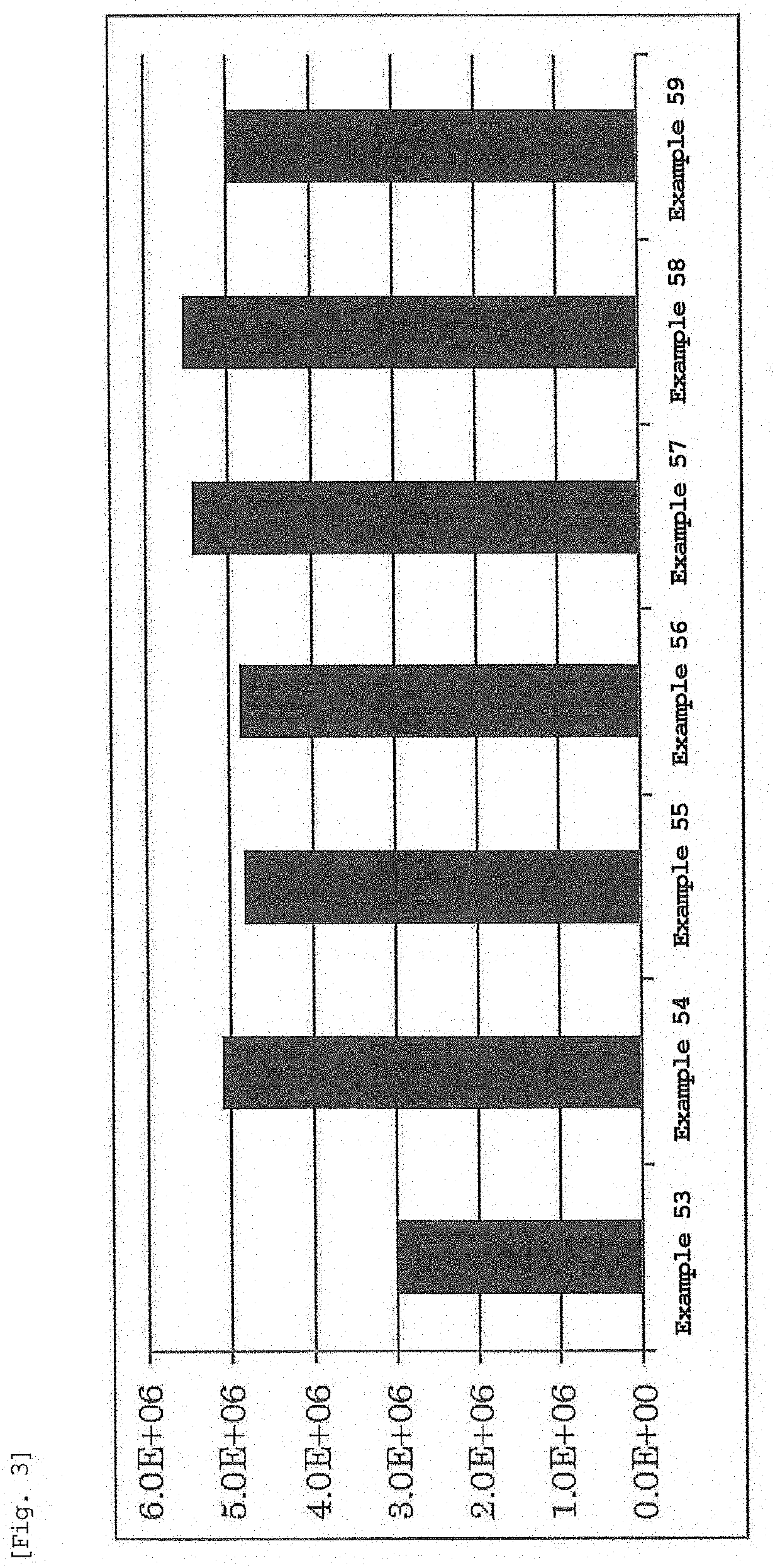Lipid nanoparticle lyophilized composition
a technology of lipid nanoparticles and compositions, applied in the direction of non-active genetic ingredients, oil/fat/waxes non-active ingredients, non-active genetic ingredients, etc., to achieve the effect of increasing the encapsulation rate of nucleic acids and preparing lipid nanoparticles
- Summary
- Abstract
- Description
- Claims
- Application Information
AI Technical Summary
Benefits of technology
Problems solved by technology
Method used
Image
Examples
experimental example 1
Evaluation of Expression Intensity and Expression Efficiency Per Cell by EGFP-mRNA-Encapsulating LNP
[0307]An LNP solution encapsulating mRNA expressing EGFP was prepared by the method described in Examples.
[0308]Jurkat cells which are human leukemia T cells were seeded in a 1.2 cm well at 5.0×104 cells / 1 mL / well 24 hr before transfection. After 24 hr, the prepared LNP solution was added to 1.2 cm well such that 0.1 μg of mRNA was contained, and the cells were cultured for 24 hr in an incubator. The culture medium was exchanged with FACS buffer (PBS containing 0.5% bovine serum albumin (BSA), 0.1% NaN3), measurement was performed by a flow cytometer (NovoCyte; manufactured by ACEA Biosciences), and transgenic cells were analyzed. The proportion of cells expressing EGFP is shown in FIG. 1, and the expression intensity of EGFP is shown in FIG. 2.
[0309]As shown in FIGS. 1 and 2, nucleic acid-encapsulating lipid nanoparticles prepared using the lyophilized composition of the present inve...
experimental example 2
Evaluation of Gene Transfer Efficiency Into Cells Using Luc-mRNA Encapsulating Lipid Nanoparticles
[0310]An LNP solution encapsulating mRNA expressing luciferase was prepared by the method described in Examples.
[0311]Jurkat cells which are human leukemia T cells were seeded in a 3.5 cm dish at 2.0×105 cells / 1.9 mL / Dish 24 hr before transfection. After 24 hr, 100 μL of a D-luciferin-containing medium (RPMI1640) was added to each dish at a final concentration of 0.1 mM. The prepared LNP solution was added thereto such that 0.4 μg of mRNA was contained, and the mixture was set in an incubator luminometer KronosDio. The luminescence intensity of luciferase was measured for 2 min every 3 hr. The cumulative luminescence intensity for 24 or 48 hr was calculated from the obtained time change of expression. The results are shown in FIGS. 3-6.
[0312]As shown in FIGS. 3-6, genes could be efficiently introduced into cells by using any of DOPC, POPC, DOPE, and POPE as a phospholipid, and the gene ...
experimental example 3
[0313]Evaluation of In Vivo mRNA Expression Efficiency in Mouse
[0314]An LNP solution encapsulating mRNA expressing erythropoietin was prepared by the method described in Examples.
[0315]The prepared LNP solution was diluted with PBS such that the concentration of mRNA was 5 μg / mL. The diluted mRNA-encapsulated LNP was administered into the tail vein of 6-week-old female Balb / c mice at 10 μL per 1 g body weight (0.05 mg / kg as dose of mRNA). The blood (15 μL) was collected from the tail vein of the mice 1, 3, 6, 9, 24 hr after the administration. The collected blood was immediately mixed with 0.3 μL of heparin solution (5000 U / 5 mL). Each blood sample was centrifuged under centrifugation conditions (25° C., 2000 g, 20 min), and the supernatant was recovered. The concentration of erythropoietin in the supernatant was measured using Mouse Erythropoietin Quantikine ELISA Kit (manufactured by R&D Systems) and by the method described in the protocol of the Kit. The results are shown in FIG....
PUM
| Property | Measurement | Unit |
|---|---|---|
| weight ratio | aaaaa | aaaaa |
| concentration | aaaaa | aaaaa |
| concentration | aaaaa | aaaaa |
Abstract
Description
Claims
Application Information
 Login to View More
Login to View More - R&D
- Intellectual Property
- Life Sciences
- Materials
- Tech Scout
- Unparalleled Data Quality
- Higher Quality Content
- 60% Fewer Hallucinations
Browse by: Latest US Patents, China's latest patents, Technical Efficacy Thesaurus, Application Domain, Technology Topic, Popular Technical Reports.
© 2025 PatSnap. All rights reserved.Legal|Privacy policy|Modern Slavery Act Transparency Statement|Sitemap|About US| Contact US: help@patsnap.com



